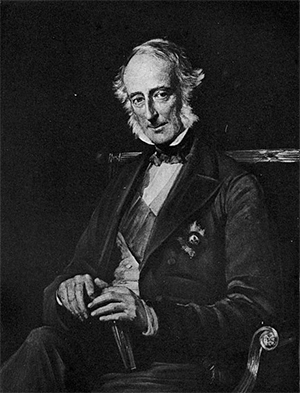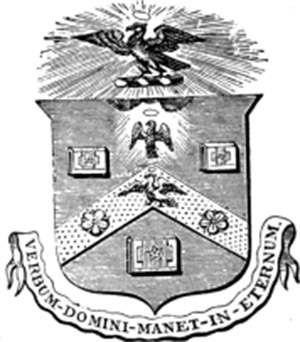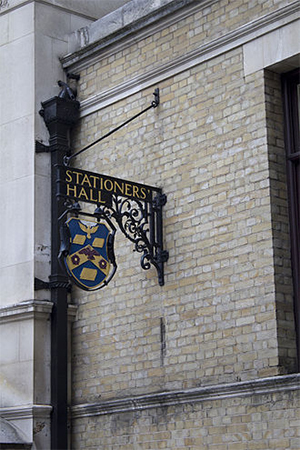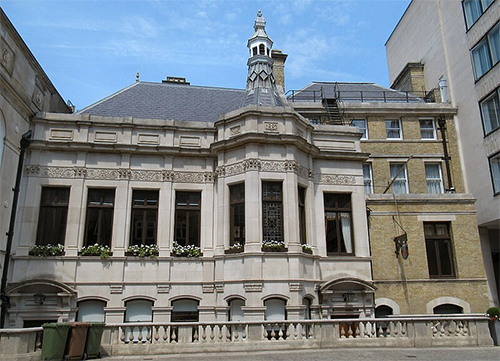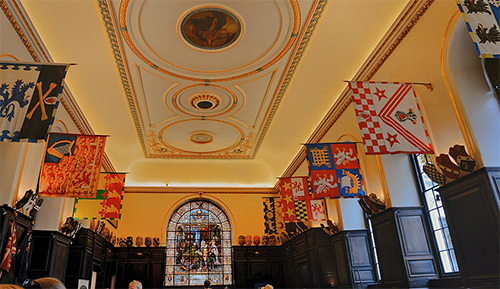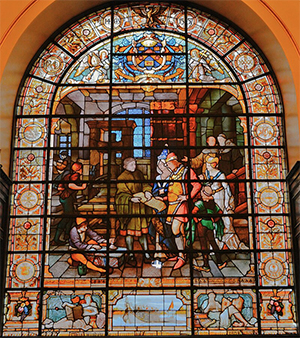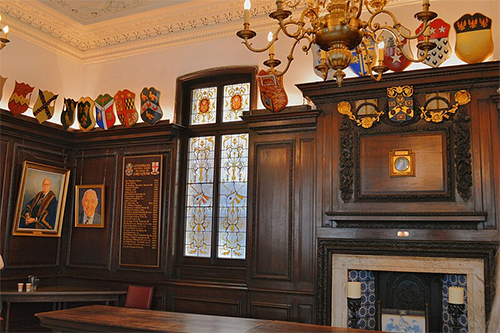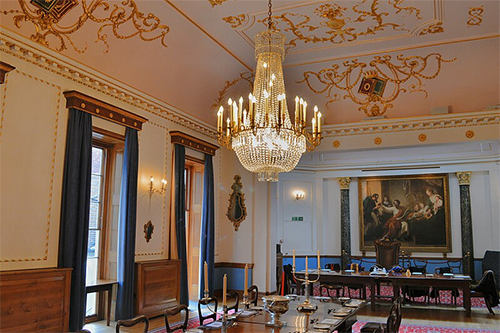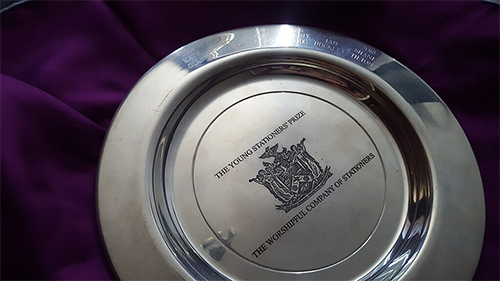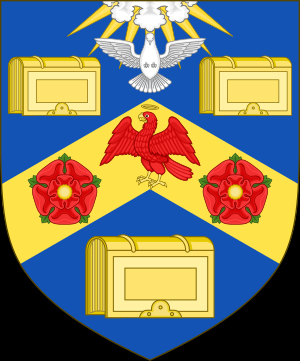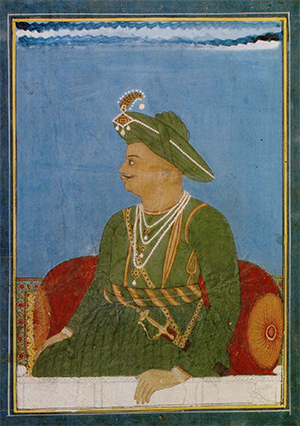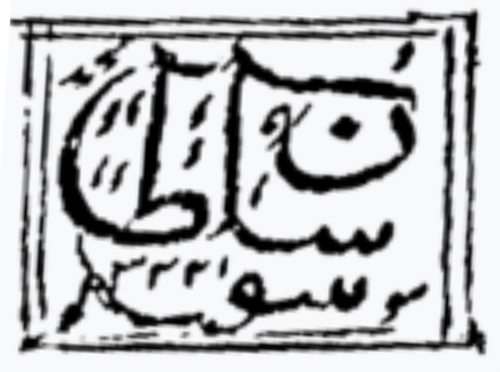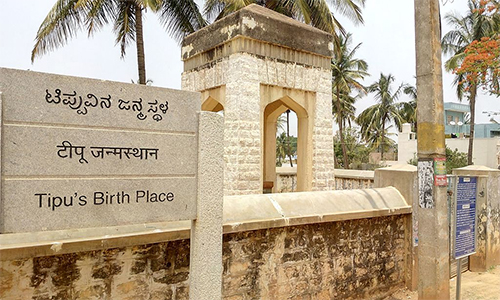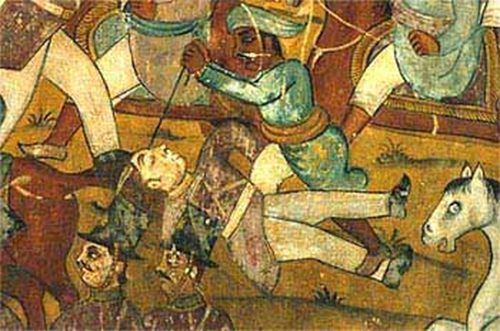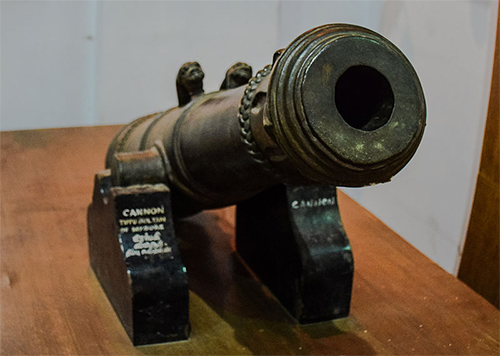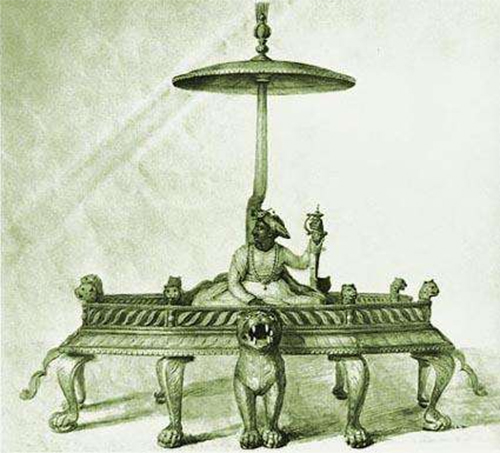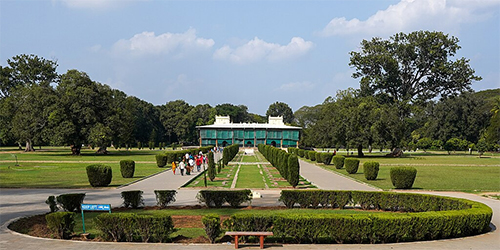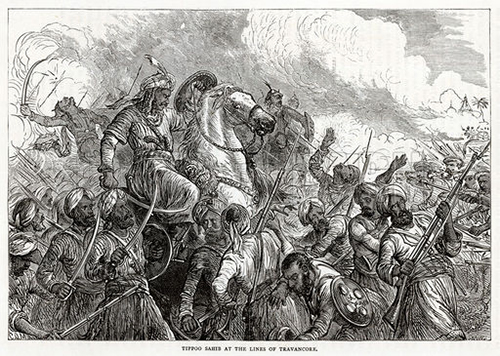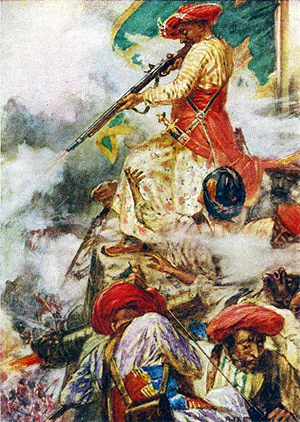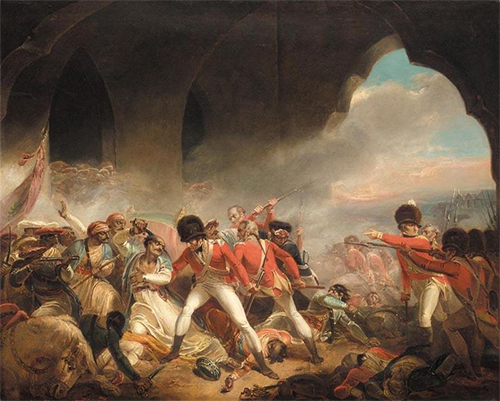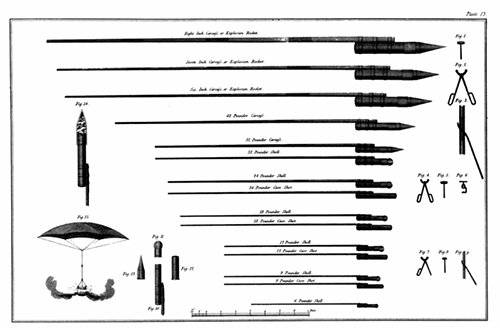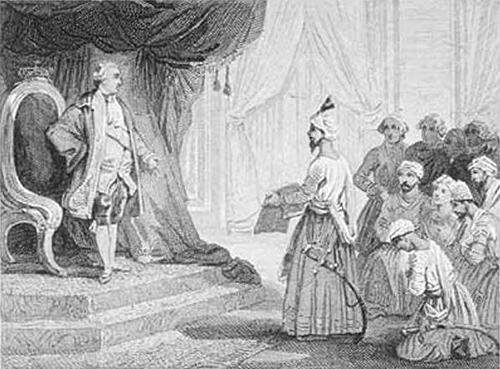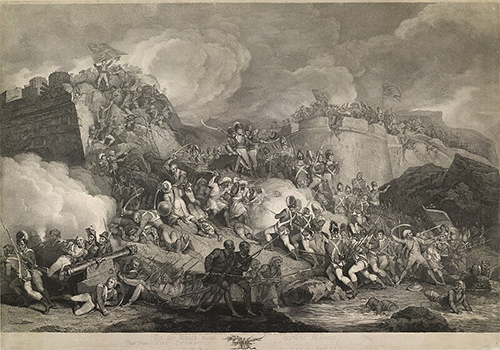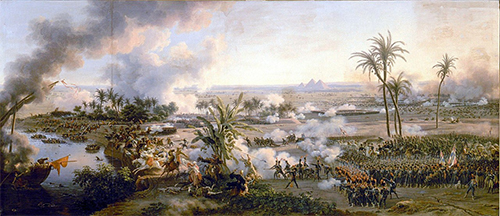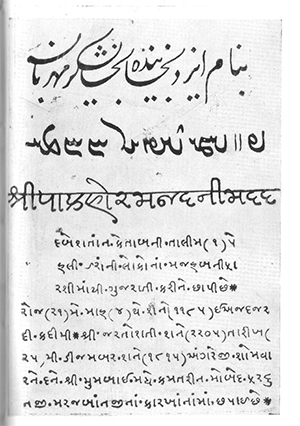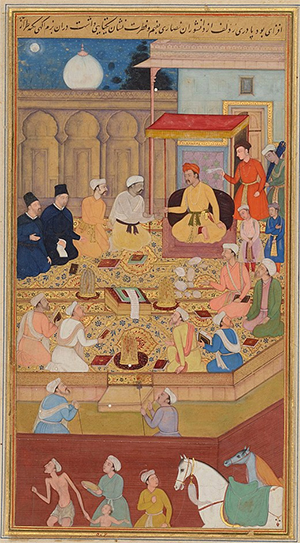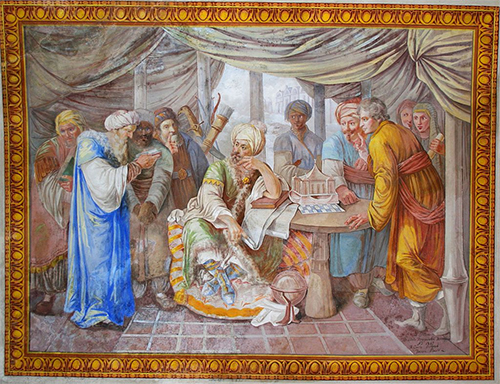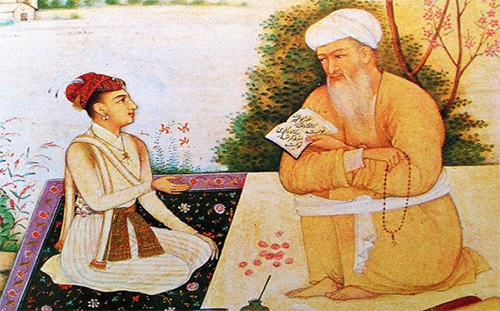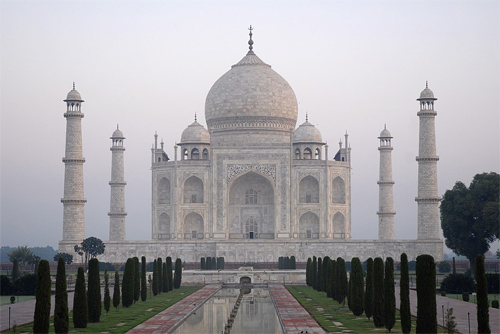Part 2 of 2
The coinage system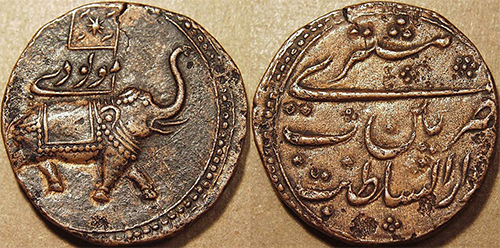 Among his many innovations, Tipu introduced new coin denominations and new coin types, including this copper double paisa weighing over 23 gm. The coin on the left also contains the emblem of the Sultanate of Mysore.
Among his many innovations, Tipu introduced new coin denominations and new coin types, including this copper double paisa weighing over 23 gm. The coin on the left also contains the emblem of the Sultanate of Mysore.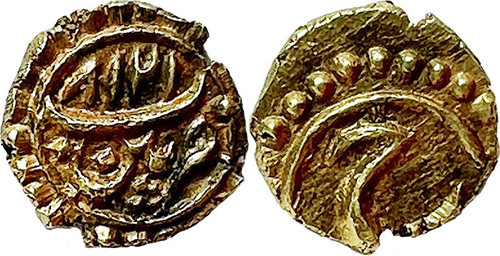 A gold coin issued by the Kingdom of Mysore during the reign of the Tipu Sultan.
A gold coin issued by the Kingdom of Mysore during the reign of the Tipu Sultan.The coinage of Tipu Sultan is one of the most complex and fascinating series struck in India during the 18th century. Local South India coinage had been struck in the area that became Mysore since ancient times, with the first gold coinage introduced about the 11th century (the elephant pagoda), and other pagodas continuing through the following centuries. These pagoda were always in the South Indian style until the reign of Haidar Ali (1761–1782), who added pagodas with Persian legends, plus a few very rare gold mohurs and silver rupees, always in the name of the Mughal emperor Shah Alam II plus the Arabic letter "ح" as the first letter of his name. His successor, Tipu Sultan, continued to issue pagodas, mohurs and rupees, with legends that were completely new. As for copper, the new large paisa was commenced by Haidar Ali in AH1195, two years before his death, with the elephant on the obverse, the mint on the reverse, and was continued throughout the reign of Tipu Sultan, who added other denominations. Tipu Sultan introduced a set of new Persian names for the various denominations, which appear on all of the gold and silver coins and on some of the copper. They were:
Copper: Qutb "قطب" for the 1/8 paisa (Persian for the pole star) – Akhtar "اختر" for the 1/4 paisa (star) – Bahram "بهرام" for the 1/2 paisa (the planet Mars) – Zohra "زهره" for the paisa (the planet Venus) – either Othmani "عثمانی" for the double-paisa (the third caliph of the Rashidun) or Mushtari "مشتری" (the planet Jupiter).
Silver: Khizri "خضری" for the 1/32 rupee (Khizr the prophet) – Kazimi "کاظمی" for the 1/16 rupee (for Musa, the seventh Shi'ite Imam) – Ja'fari "جعفری" for the 1/8 rupee (Ja'far al-Sadiq, the sixth Shi'ite Imam) – Bâqiri "باقری" for the 1/4 rupee (Muhammad al-Baqir, the fifth Imam) – Abidi "عبیدی" for the 1/2 rupee (Ali Zain al-'Abidin, the fourth Imam) – Imami for the rupee (reference to the 12 Shi'ite Imams) – Haidari "حیدری" for the double-rupee (lion, for Ali b. Abi Talib, who was both the fourth caliph and the first Shi'ite Imam).
Gold: Faruqi "فاروقی" for the pagoda (Umar al-Faruq, the second caliph) – Sadîqi "صدیقی" for the double-pagoda (Abu Bakr al-Sadiq, the first caliph) – Ahmadi "احمدی" for the four-pagoda ( "most praised ", one of the name of the Islamic prophet Muhammad). During his first 4 years, the large gold coin was the mohur, with an average weight of about 10.95g (AH1197-1200), replaced with the four-pagoda of 13.74g with the calendar change to the Mauludi "مولودی" system (AM1215-1219).
Coinage dating system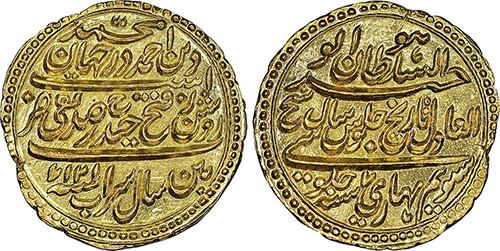 2 gold Two Pagoda Coins issued by tipu Sultan
2 gold Two Pagoda Coins issued by tipu SultanThe denomination does not appear on the Hijri dated gold coins, but was added on all the Mauludi dated pieces.
At the beginning of his first year, Tipu Sultan abandoned the Hijri dating system and introduced the Mauludi system (from the Arabic word "walad ", which means "birth "), based on the solar year and the birth year of Muhammad (actually 571 AD, but for some perplexing reason reckoned as 572 by Tipu Sultan for his staff).
From the beginning of his reign, Tipu Sultan added the name of the Indian cyclic year on the large silver and gold coins, including this double-pagoda, together with his regnal year. Each of the names is Persian, though in several examples, the meaning of the names in India was different from the Iranian meaning (not indicated here). According to the Indian meanings, these are the cyclic years: Zaki "زکي" for cyclic 37, which corresponded to his year 1 ( "pure ") – Azâl "أزل" for 38 ( "eternity ", year 2) – Jalal "جَلال" for 39 ( "splendor ", year 3) – Dalv "دَلو" for 40 (the sign of Aquarius, year 4) – Shâ "شاه" for 41 ( "king ", year 5) – Sârâ "سارا" for 42 ( "fragrant ", year 6) – Sarâb "سراب" for 43 ( "mirage ", for year 7) – Shitâ "شتا" for 44 ( "winter ", year 8) – Zabarjad "زبرجد" for 45 ( "topaz ", year 9) – sahar "سَحَر" ( "dawn ", year 10) – Sâher "ساحِر" ( "magician ", year 11).[111]
Assessment and legacy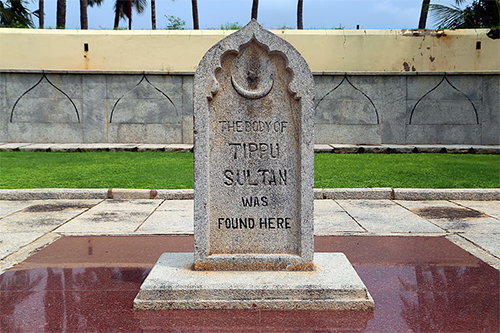 The spot in Srirangapatna where Tipu's body was found
The spot in Srirangapatna where Tipu's body was foundAssessments of Tipu Sultan have often been passionate and divided. Successive Indian National Congress governments have often celebrated Tipu Sultan's memory and monuments and relics of his rule while the Bharatiya Janata Party has been largely critical. School and college textbooks in India officially recognize him as a "freedom-fighter" along with many other rulers of the 18th century who fought European powers.[112] The original copy of the Constitution of India bears a painting of Tipu Sultan.[113]
In 2017 the 14th Indian president Ram Nath Kovind hailed Tipu Sultan in his address to the Karnataka Assembly on the occasion of the Diamond Jubilee celebrations of the state secretariat Vidhana Soudha saying "Tipu Sultan died a heroic death fighting the British. He was also a pioneer in the development and use of Mysore rockets in warfare. This technology was later adopted by the Europeans."[114]
Tipu Sultan is also admired as a hero in Pakistan. Former Pakistani Prime Minister Imran Khan has said that he admires Tipu Sultan as a freedom fighter.[115]
Tipu also patronised art forms such as Ganjifa cards, effectively saving this art form.[116] Ganjifa card of Mysore have the GI Tag today.[117]
Sword and tigerMain article: Tipu's Tiger
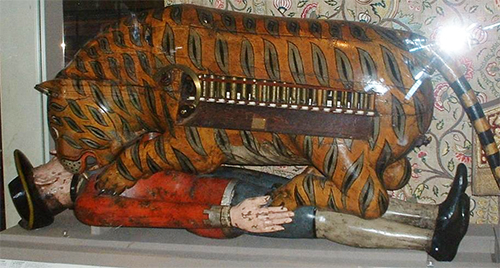 Tipu Sultan's Tiger. Victoria and Albert Museum, London
Tipu Sultan's Tiger. Victoria and Albert Museum, London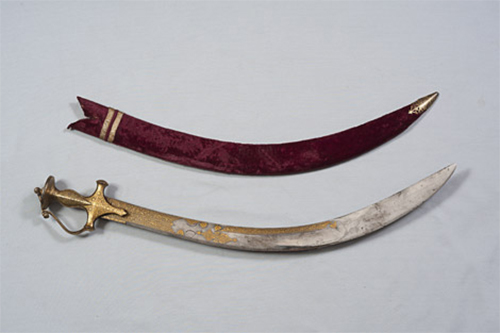 Sword of Tipu Sultan. National Museum, New Delhi
Sword of Tipu Sultan. National Museum, New DelhiTipu Sultan had lost his sword in a war with the Nairs of Travancore during the Battle of the Nedumkotta (1789), in which he was forced to withdraw due to the severe joint attack from the Travancore army and British army.[118] The Nair army under the leadership of Raja Kesavadas again defeated the army of Tipu near Aluva. The Maharaja, Dharma Raja, gave the famous sword to the Nawab of Arcot, from whom the sword was taken as a war trophy by the British after annexing Arcot and sent to London. The sword was on display at the Wallace Collection, No. 1 Manchester Square, London.
Tipu was commonly known as the Tiger of Mysore and adopted this animal as the symbol (bubri/babri)[119] of his rule.[120] It is said that Tipu Sultan was hunting in the forest with a French friend. They came face to face with a tiger there. The tiger first pounced on the French soldier and killed him. Tipu's gun did not work, and his dagger fell on the ground as the tiger jumped on him. He reached for the dagger, picked it up, and killed the tiger with it. That earned him the name "the Tiger of Mysore". [citation needed] He even had French engineers build a mechanical tiger for his palace.[121] The device, known as Tipu's Tiger, is on display in the Victoria and Albert Museum, London.[122] Not only did Tipu place relics of tigers around his palace and domain, but also had the emblem of a tiger on his banners and some arms and weapons. Sometimes this tiger was very ornate and had inscriptions within the drawing, alluding to Tipu's faith – Islam.[123] Historian Alexander Beatson reported that "in his palace was found a great variety of curious swords, daggers, fusils, pistols, and blunderbusses; some were of exquisite workmanship, mounted with gold, or silver, and beautifully inlaid and ornamented with tigers' heads and stripes, or with Persian and Arabic verses".[124]
The last sword used by Tipu in his last battle, at Sri Rangapatnam, and the ring worn by him were taken by the British forces as war trophies. Till April 2004, they were kept on display at the British Museum London as gifts to the museum from Maj-Gen Augustus W.H. Meyrick and Nancy Dowager.[125] At an auction in London in April 2004, Vijay Mallya purchased the sword of Tipu Sultan and some other historical artefacts, and brought them back to India.[126]
In October 2013, another sword owned by Tipu Sultan and decorated with his babri (tiger stripe motif) surfaced and was auctioned by Sotheby's.[127] It was purchased for £98,500[128] by a telephone bidder.
Tipu Sultan JayantiIn 2015, the Government of Karnataka, under the leadership of then Chief Minister Siddaramaiah from the Congress party, began to celebrate Tipu's birth anniversary as the "Tipu Sultan Jayanti".[129] The Congress regime declared it as an annual event to be celebrated on 20 November.[130] It was officially celebrated in Karnataka initially by the Minority Welfare department, and later by the Kannada & Culture department. However, on 29 July 2019, the next Chief Minister B. S. Yediyurappa, who belongs to the Bharatiya Janata Party (BJP), ordered the celebrations cancelled, saying: "Legislators from Kodagu had highlighted incidents of violence during Tipu Jayanti."
Objecting against the cancellation of the celebrations, the previous Chief Minister Siddaramaiah said: "BJP has cancelled it because of their hatred towards minorities. It's a big crime. He [Tipu] was a king of Mysore and fought against the British [as] a freedom fighter. It was during his time when the foundation was laid for the Krishna Raja Sagara dam. He also tried to improve industry, agriculture and trade". The previous year, not a single JD(S) leader, including the then chief minister HD Kumaraswamy, attended the event, turning it into a fiasco.[129]
The Lok Sabha Congress leader, Mallikarjun Kharge, also earlier criticized BJP and RSS for their opposition against holding the celebrations, and asked: "When RSS can celebrate Nathuram Godse, can't we celebrate Tipu Sultan?"[131]
In fiction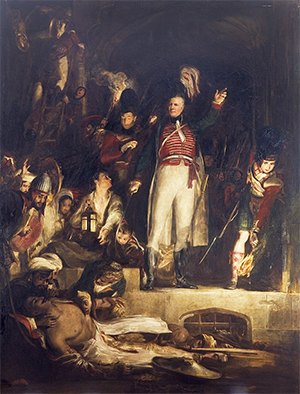 Sir David Baird Discovering the Body of Sultan Tipoo Sahib by David Wilkie, 1839
Sir David Baird Discovering the Body of Sultan Tipoo Sahib by David Wilkie, 1839• He has a role in G. A. Henty's 1896 book The Tiger of Mysore,[132] and is also mentioned in Henty's 1902 At the Point of the Bayonet,[132] which deals with much of the same period.
• In Jules Verne's Mysterious Island, Captain Nemo is described as Tipu's nephew.
• He was portrayed by Paidi Jairaj in the 1959 Indian historical drama film Tipu Sultan, directed by Jagdish Gautam.[133]
• Bharat Ek Khoj, a 1988 Indian television series based on Jawaharlal Nehru's The Discovery of India which aired on DD National, dedicated an episode to Tipu Sultan with Salim Ghouse portraying the king.
• Tipu's life and adventures were the central theme of a short-running South Indian television series The Adventures of Tipu Sultan, and of a more popular national television series The Sword of Tipu Sultan based on a historical novel by Bhagwan Gidwani.[134][135]
• The Dreams of Tipu Sultan is a 1997 play written in Kannada by Indian writer Girish Karnad. It follows the last days as well as the historic moments in the life of Tipu, through the eyes of an Indian court historian and a British Oriental scholar.
• Tipu Sultan: The Tiger Lord is a Pakistani television series that broadcast on PTV in 1997, deals with the life of Sultan.
• Naseem Hijazi's novels Muazam Ali and Aur Talvar Ṭūṭ Gaye (And The Sword Broke) describe Tipu's wars.
• Wilkie Collins's novel The Moonstone contains an account of Tipu and the fall of Srirangapatna in the prologue.
• In The Surprising Adventures of Baron Munchausen by Rudolf Erich Raspe, Munchausen vanquishes Tipu near the end of the novel.
• Sharpe's Tiger is a novel by Bernard Cornwell in which Napoleonic–era British soldier Richard Sharpe fights at Seringapatam, later killing Tipu.
• Tipu appears as a "Great Person" in the video games, Sid Meier's Civilization: Revolution and Sid Meier's Civilization IV.
• In his historical Konkani-language novels on the Seringapatam captivity of Konkani Catholics by Indian littérateur V. J. P. Saldanha, Belthangaddicho Balthazar (Balthazar of Belthangady), Devache Krupen (By the Grace of God), Sardarachi Sinol (The sign of the Knights) and Infernachi Daram (The gates of Hell), Tipu is portrayed as "cunning, haughty, hard-hearted, revengeful, yet full of self-control".[136]
Family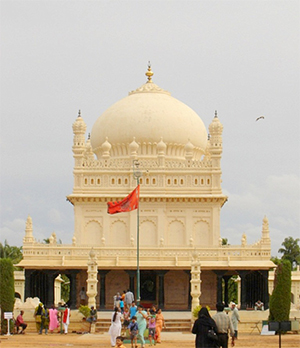 The mausoleum housing Tipu Sultan's tomb is another example of Islamic architecture. Tipu Sultan's flag is in the foreground.
The mausoleum housing Tipu Sultan's tomb is another example of Islamic architecture. Tipu Sultan's flag is in the foreground.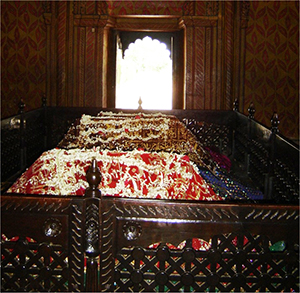 The tomb of Tipu Sultan at Srirangapatna. Tipu's tomb is adjacent to his mother's and father's graves.
The tomb of Tipu Sultan at Srirangapatna. Tipu's tomb is adjacent to his mother's and father's graves.Tipu had several wives.[137] His first wife was Sultan Begum Sahib also known as Padishah Begum.[138] She was the daughter of Imam Sahib Bakhshi Naita from Arcot,[139] and sister of Ghulam Husain Khan, known as the Pondicherry Nawab, a descendant of Chanda Sahib.[138] They married in 1774.[140] Another wife married at the same time was Ruqaya Banu Begum. She was the daughter of Lala Miyan Shaheed Charkoli,[141] and the sister of Sheikh Burhanuddin.[142] She died in February 1792 at the time of the siege of Seringapatam.[139] Another wife was Khadija Zaman Begum. She was the daughter of Mir Sayyid Moinuddin Khan[142] also known as Sayyid Sahib.[143] They married in 1796. She died in childbirth in 1797.[140] Another wife was Buranti Begum. She was the daughter of Mir Muhammad Pasand Beg, a nobleman from Delhi and her mother's father was Sayyid Muhammad Khan, once a subedar of Kashmir. Another wife was Roshani Begum. She was the mother of his eldest son Fath Haider.[138]
His sons were Hyder Ali Khan Sultan,[144] Muin-ud-din Sultan, Abdul Khaliq Sultan, Muiz-ud-din Sultan, Muhammad Subhan Sultan, Shukrullah Sultan, Ghulam Ahmad Sultan, Ghulam Muhammad Sultan, Sarwar-ud-din Sultan, Muhammad Yasin Sultan, Jamal-ud-din Sultan and Munir-ud-din Sultan. One of his daughters was married to Husain Ali Khan.[138] Many of Tipu's descendants live in Kolkata and have expressed objection to use of Tipu Sultan's name by political parties for polarising votes.[145][146]
Image gallery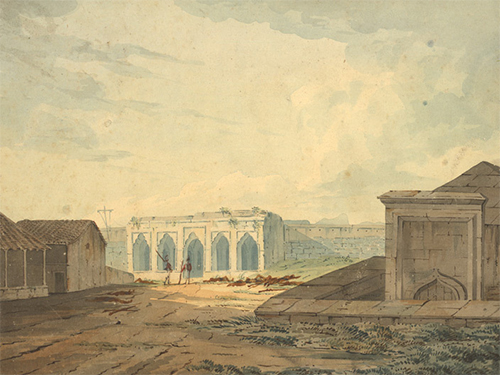 A view of the Hoally Gateway, Srirangapatnam, where Tipu Sultan was killed, Seringapatam (Mysore), by Thomas Sydenham (c. 1799)
A view of the Hoally Gateway, Srirangapatnam, where Tipu Sultan was killed, Seringapatam (Mysore), by Thomas Sydenham (c. 1799)  A flintlock blunderbuss, made for Tipu Sultan in Srirangapatnam in 1793–94. Tipu Sultan used many Western craftsmen, and this gun reflects the most up-to-date technologies of the time.[25]
A flintlock blunderbuss, made for Tipu Sultan in Srirangapatnam in 1793–94. Tipu Sultan used many Western craftsmen, and this gun reflects the most up-to-date technologies of the time.[25]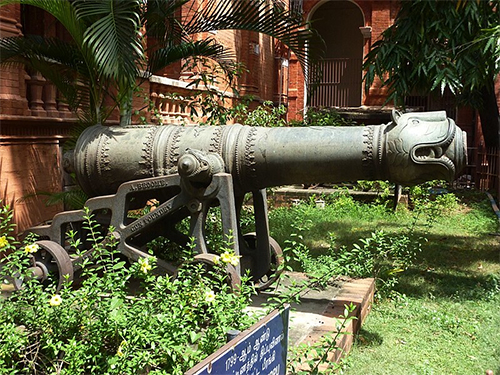 Cannon used by Tipu Sultan in the battle of Srirangapatnam 1799
Cannon used by Tipu Sultan in the battle of Srirangapatnam 1799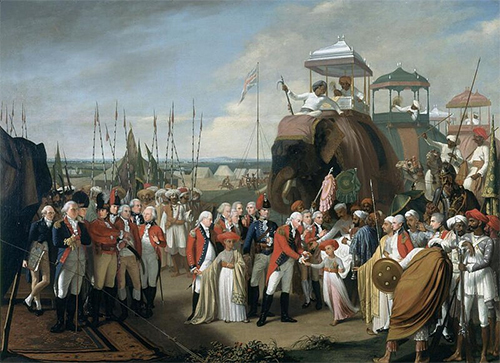 General Lord Cornwallis, receiving two of Tipu Sultan's sons as hostages in the year 1793.
General Lord Cornwallis, receiving two of Tipu Sultan's sons as hostages in the year 1793.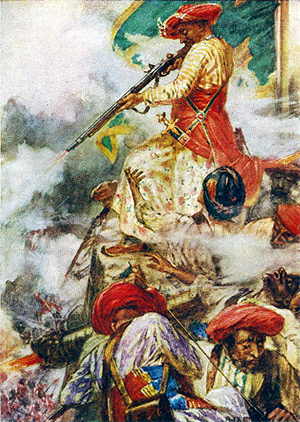 During the Republic Day Parade in 2014, in New Delhi, the tableau of Karnataka, highlighting "Tipu Sultan: The Tiger of Mysore," made its way through the Rajpath.See also
During the Republic Day Parade in 2014, in New Delhi, the tableau of Karnataka, highlighting "Tipu Sultan: The Tiger of Mysore," made its way through the Rajpath.See also• Muslim warriors
• Mysore invasion of Kerala
• PNS Tippu Sultan
• Tipu Sultan Mosque
• The Sword of Tipu Sultan – an Indian TV series on Tipu Sultan
• Tipu's Tiger
• The Dreams of Tipu Sultan by Girish Karnad
• Mir Ghulam Ali, an official and senior military commander
References1. H. Davis, Richard (1999). Lives of Indian Images. Chichester, West Sussex, UK: Princeton University Press. p. 149. ISBN 0-691-00520-6. Both Haidar 'Ali and Tipu Sultan were parvenu Sunni Muslim rulers...
2. The Writing of the Nation by Its Elite: The Politics of Anglophone Indian Literature in the Global Age. 605 Third Avenue, New York, NY 10158, USA: Routledge. 2022. ISBN 978-0-367-54129-3.
3. Yazdani, Kaveh (2017). "2: Mysore". India, Modernity and the Great Divergence: Mysore and Gujarat (17th to 19th C.). Brill. p. 312, 313. doi:10.1163/9789004330795_004. ISBN 978-90-04-33078-8. ISSN 1877-3206. After coming into power, Tipu ordered his 'ulama' to collect significant matters of Mohammadan law, especially those corresponding to the Hanafi School of thought. As a result, a Persian treatise on the important laws of Islam called Fiqh-i Mohammadi was written down. Indeed, the existing sources suggest that Tipu was in all likelihood a Sunni Muslim who belonged to the Hanafi School.
4. "6: The Private as Public". The Politics of Modern Indian Language Literature. 605 Third Avenue, New York, NY 10158, USA: Routledge. 2024. ISBN 978-1-032-69578-5.
5. Cavendish, Richard (4 May 1999). "Tipu Sultan killed at Seringapatam". History Today. 49 (5). Retrieved 13 December 2013.
6. Brittlebank, Kate (2022). Tiger: The Life of Tipu Sultan. Claritas Books. ISBN 978-1-905837-87-8. Retrieved 15 April 2024. Quote=Aer he died, it became his epithet – 'the Tiger of Mysore' the British called him.
7. Yazdani, Kaveh (2017). India, Modernity and the Great Divergence. Brill. p. 67. ISBN 9789004330795.
8. Colley, Linda (2000). "Going Native, Telling Tales: Captivity, Collaborations and Empire". Past & Present (168): 190. ISSN 0031-2746. JSTOR 651308.
9. Dalrymple 2019, p. 243.
10. Jamil, Arish. "Why Mysore? The Idealistic and Materialistic Factors Behind Tipu Sultan's War Rocket Success" (PDF). Emory Endeavors in World History – Volume 5. Emory College of Arts and Science. Retrieved 21 May 2022.
11. Narasimha, Roddam (27 July 2011). "Rockets in Mysore and Britain, 1750–1850 A.D." (PDF). National Aeronautical Laboratory and Indian Institute of Science. Archived from the original on 27 July 2011.
12. Roy 2011, p. 77.
13. Hasan 2005, pp. 105–107.
14. Hasan 2005, p. 399.
15. Datta, R.K. (2007). Global Silk Industry: A Complete Source Book. APH Publishing. p. 17. ISBN 978-81-313-0087-9.
16. "History of Channapatna Toys". Craftdeals.in. January 2023. Retrieved 1 January 2023.
17. Hasan 2005, p. 6.
18. "Rewriting History: How I Discovered the True Birth Date of Tipu Sultan". News18. 19 July 2021. Retrieved 22 July 2021.
19. "The history of South India is relatively unknown: Rajmohan Gandhi". Business Standard India. 9 December 2018.
20. Haroon, Anwar (June 2013). Kingdom of Hyder Ali and Tipu Sultan. Xlibris Corporation. p. 95. ISBN 9781483615349.
21. Wenger 2017, p. 4.
22. "The Sultan of Mysore – Tipu Sultan". Karnataka.com. Retrieved 7 August 2019.
23. Coller, Ian (2020). Muslims and Citizens:Islam, Politics, and the French Revolution. Yale University Press. p. 31. ISBN 9780300243369.
24. Subrahmanyam, Sanjay (2017). Europe's India: Words, People, Empires, 1500–1800. Harvard University Press. ISBN 9780674977556.
25. Exhibition at the Metropolitan Museum of Art, New York.
26. Chisholm 1911.
27. Beatson, Alexander (1800). "Appendix No. XXXIII". A View of the Origin and Conduct of the War with Tippoo Sultaun. London: G. & W. Nichol. pp. ci–civ. Archived from the original on 9 June 2013.
28. Fortescue, John William (1902). A history of the British army, Volume 3. Macmillan. pp. 431–432.
29. "The Tiger and The Thistle – Tipu Sultan and the Scots in India". nationalgalleries.org. Archived from the original on 11 November 2006.
30. The Parliamentary History of England from the Earliest Period to the Year 1803. T.C. Hansard. 1817.
31. Brittlebank, K. (2022). Tiger: The Life of Tipu Sultan. Claritas Books. ISBN 978-1-905837-87-8. Retrieved 15 April 2024.
32. Roy 2011, p. 72.
33. Naravane, M. S. (2006). Battles of the Honourable East India Company: Making of the Raj. APH Publishing. ISBN 9788131300343.
34. Sen 1995, p. 54.
35. Hasan 2005, p. 105.
36. Sen 1995, p. 59.
37. Moienuddin 2000.
38. Hasan 2005, p. 105; Sen 1995, p. 59.
39. Dictionary of Indian biography. London S. Sonnenschein. 1906.
40. "Tipu Sultan – Personalities". Karnataka.com. 10 November 2016.
41. Wenger 2017, pp. 11–.
42. Roychoudhury, Upendrakishore (April 2004). White Mughals. Penguin Books India. p. 101. ISBN 978-0-14-303046-1.
43. Boutier, Jean (2005). "Les "lettres de créances" du corsaire Ripaud. Un "club jacobin" à Srirangapatnam (Inde), mai-juin 1797". Les Indes Savantes.
44. Watson, William E. (2003). Tricolor and Crescent. Greenwood Publishing. ISBN 9780275974701.
45. Amini, Iradj (January 1999). Napoleon and Persia. Mage Publishers. ISBN 9780934211581.
46. Karsh, Efraim; Karsh, Inari (2001). Empires of the Sand. Harvard University Press. ISBN 9780674005419.
47. Francis, P. Sempa. "Wellington in India: A Great Commander in Embryo". thediplomat.com. Retrieved 16 September 2020.
48. The Parliamentary Register; Or, History of the Proceedings and Debates of the [House of Lords and House of Commons]-J. Almon, 1793
49. Zachariah, Mini Pant (7 November 2010). "Tipu's legend lives on". The Hindu. Archived from the original on 29 October 2013. Retrieved 18 December 2013.
50. Sunderlal, Pandit (2018). How India Lost Her Freedom. SAGE Publications. p. 364. ISBN 978-93-5280-642-3. Retrieved 20 January 2022.
51. "Tipu Sultan: Here're lesser known facts about 'Tiger of Mysore'". The Siasat Daily. 2 November 2019. Retrieved 16 September 2020.
52. "Tipu, the Citizen-Sultan and the Myth of a Jacobin Club in India". The Wire.
53. Speake, Jennifer; Simpson, John (23 October 2008). Better to live one day as a tiger than a thousand years as a sheep. OUP Oxford. ISBN 978-0-19-953953-6. Retrieved 14 February 2017. {{cite book}}: |website= ignored (help)
54. "View of the Hoally Gateway, where Tipu Sultan was killed, Seringapatam (Mysore)". British Library Online Gallery. Retrieved 14 June 2009.
55. Rafiq, Ayesha (20 November 2018). "A Revaluation of tales of concerning Tipu Sultan's defeat". Daily Times. Retrieved 13 July 2022.
56. Brittlebank, Kate (22 July 2016). "Seven things you may not have known about Tipu Sultan, India's first freedom fighter". Scroll.in. Archived from the original on 19 March 2022.
57. Sengupta, Anjali (1984). Cameos of Twelve European Women in India, 1757-1857. Ṛddhi-India. p. 11. OCLC 13531696.
58. "Over 5,000 'war rockets' of Tipu Sultan unearthed". Deccan Herald. 28 July 2018. Retrieved 16 September 2020.
59. "How the Mysorean rocket helped Tipu Sultan's military might gain new heights". 5 August 2018.
60. Roy 2011, p. 22.
61. Gopal, Mysore Hatti (1960). The Finances Of The Mysore State 1799 – 1831. Orient Longmans. p. 255. These were armed militia who served as police officers, helped in the collection of revenue and often garrisoned small forts . They resembled the sibundi in the Company ' s territories . In Mysore they were divided into the huzur kandachar or those who were in the capital and about the Maharaja, and the taluq kandachar or those in the taluqs, the latter being far more numerous than the former.
62. R. Gopal, ed. (2010). Tipu Sultan: The Tiger of Mysore. Mysore: Directorate of Archaeology and Museums, Government of Karnataka. p. 279. OCLC 813417527. Since Haidar and Tipu were perpetually engaged in battles, they formed a disciplined standing army . Thus, instead of the local militia called the Kandachar force of agricultural origin which existed in the Mysore army earlier, Haidar and Tipu enrolled to their army forces the able tribal men, Muslims and Rajputs on full time service. In this way, Haidar and Tipu removed the Vokkaligas of the agricultural base from the local militia which took part in wars for centuries and in place of their quit rent, they imposed higher taxes and thus became indirectly responsible for implementation of Ryotwari system. The Ryots were not liberated from the shackles of Kandachar service; the slaves who were with them were enrolled in the army in some places. As a result, the Ryots removed from the military service could not even rely upon slaves for their agricultural activities. Hence these ryots had to endure the greater responsibility of feeding the slaves and of financing their marriages besides paying the higher taxes. So in the plains of Mysore the system of slavery was loosened.
63. Parthasarathi 2011, p. 207.
64. Parthasarathi 2011, pp. 38, 271.
65. Parthasarathi 2011, p. 45.
66. "Tiger of Mysore: Saviour or savage?". Deccan Chronicle. 4 August 2019. Retrieved 22 September 2019.
67. Shekhar, Divya (10 November 2017). "How Tipu Sultan was the original tech innovator". The Economic Times. Retrieved 22 September 2019.
68. Hunter, William Wilson (1886). The Indian empire : its peoples, history, and products. Trubner, London. p. 512. Retrieved 21 June 2020.
69. Handmade in India: A Geographic Encyclopedia of Indian, Page 362, Aditi Ranjan, M. P. Ranjan (2009)
70. Edgar, Thurston. The Madras presidency, with Mysore, Coorg and the associated states. Cambridge, University press. p. 185. Retrieved 9 May 2020.
71. B. Sheik Ali (August 1999). "The Vision and Mission of Tipu Sultan". Islamic Voice. Archived from the original on 5 October 2011. Retrieved 16 August 2011.
72. Brittlebank 1999, p. [page needed].
73. Özcan, Azmi (1997). Pan-Islamism: Indian Muslims, the Ottomans and Britain, 1877–1924. BRILL. ISBN 978-90-04-10632-1.
74. Kausar, Kabir (1980). Secret correspondence of Tipu Sultan. Light and Life Publishers. plight.
75. Bhacker, Mohmed Reda (1992). Trade and Empire in Muscat and Zanzibar: The Roots of British Domination. Routledge. ISBN 978-0-415-07997-6.
76. "A sultan's silken dreams". downtoearth.org.in. Retrieved 21 August 2022.
77. "Tipu Sultan and the Scots in India". The Tiger and The Thistle. Archived from the original on 21 November 2008. Retrieved 11 March 2017.
78. Panikkar, K.N. (1991). "Men of Valour and Vision". Social Scientist. 19 (8): 110. doi:10.2307/3517708. JSTOR 3517708.
79. Sastri 1943, p. 269.
80. Naik, B. Shreedhara. The society and politics in South Kanara 1500 A D to 1800 A D (PDF). p. 211. Retrieved 7 September 2019.
81. Miller, Rolland E. (27 April 2015). Mappila Muslim Culture. State University of New York Press. p. 34. ISBN 9781438456027. Retrieved 28 March 2020.
82. Sastri 1943, p. 270.
83. Yadav, Bhupendra (1990). "Tipu Sultan: Giving 'The Devil' His Due". Economic and Political Weekly. 25 (52): 2835–2837. JSTOR 4397149.
84. A. Subbaraya Chetty "Tipu's endowments to Hindus and Hindu institutions" in Confronting Colonialism
85. Pande, B. N. (1996). Aurangzeb and Tipu Sultan: Evaluation of Their Religious Policies. University of Michigan. ISBN 9788185220383.
86. Hasan 2005, pp. 357–358.
87. Confronting Colonialism, p. 118
88. A. Subbaraya Chetty, "Tipu's endowments to Hindus", pp. 111–115 in Confronting Colonialism.
89. Hasan 2005, p. 360.
90. The Chaldean Syrian Church of the East. ISPCK. 1983. p. 30.
91. Brittlebank 1999, pp. 1–3.
92. Valath, V. V. K. (1981). Keralathile Sthacharithrangal – Thrissur Jilla (in Malayalam). Kerala Sahithya Academy. pp. 74–79.
93. Goel, Sita Ram (1993). Tipu Sultan: Villain Or Hero? : an Anthology. Voice of India. ISBN 978-81-85990-08-8.
94. Farias, Kranti K. (1999), The Christian Impact on South Kanara, Church History Association of India, p. 76
95. Cariappa, M. P.; Cariappa, Ponnamma (1981), The Coorgs and their Origins, Aakar Books, p. 48, OCLC 641505186
96. Sarasvati's Children Archived 6 December 2022 at the Wayback Machine, Joe Lobo
97. Kirkpatrick, W. (1811) Select Letters of Tipu Sultan, London
98. Wilks, M. (1930) Report on the Interior Administration, Resources and Expenditure of the Government of Mysore under the System prescribed by the Order of the Governor-General in Council dated 4 September 1799, Bangalore 1864, and Historical Sketches of the South of India in an Attempt to Trace the History of Mysore, 2 vols, ed. M. Hammick, Mysore.
99. Habib, Irfan (2001). "War and Peace. Tipu Sultan's Account of the last Phase of the Second War with the English, 1783-4", p. 5 in State and Diplomacy Under Tipu Sultan: Documents and Essays, Manohar Publishers and Distributors, ISBN 81-85229-52-X
100. A. Subbaraya Chetty "Tipu's endowments to Hindus and Hindu institutions", p. 111 in Confronting Colonialism
101. Hasan 2005, p. 368.
102. Brittlebank 1999, pp. 2–12.
103. Sampath, Vikram (31 January 2014). "Why we love to hate Tipu Sultan". livemint.com.
104. Annual Report of the Mysore Archaeological Department 1916 pp 10–11, 73–6
105. Hasan 2005, p. 359.
106. Saletare, B.A. "Tipu Sultan as Defender of the Hindu Dharma", pp. 116–8 in Confronting Colonialism
107. Prabhu 1999, p. 223.
108. Hasan 2005, p. 79.
109. Sen, Surendranath (1930). Studies in Indian history. University of Calcutta. p. 157.
110. Sultan, Tipu (1811). Select letters of Tippoo Sultan to various public functionaries. London: Black. p. 228.
111. "CoinArchives.com Lot Viewer". coinarchives.com. Retrieved 17 April 2019.
112. Moudgal, Sandeep (1 November 2019). "Tipu Sultan history lessons can't be erased, says textbook committee chairman". The Times of India.
113. Ramdas, Inayat (27 January 2016). "Bet You Didn't Know All This About the Indian Constitution!". TheQuint. Retrieved 27 September 2020.
114. Aji, Sowmya (26 October 2017). "President Ram Nath Kovind hails Tipu Sultan, sparks war of words between Congress and BJP". The Economic Times.
115. "Pakistan PM Imran pays tribute to Tipu Sultan on his death anniversary". The Hindu. 5 May 2019.
116. "Untitled" (PDF). ccrt.addsofttech.com. Archived from the original (PDF) on 16 February 2022. Retrieved 16 February 2022.
117. "Geographical Indications".
118. "The swords of Tipu Sultan". The Hindu. 3 May 2011. Archived from the original on 9 May 2011.
119. "Tipu Sultan and the tiger motif". The Seringapatnam Times. Toshkhana : wordpress. 17 August 2011. Retrieved 13 December 2013.
120. Brittlebank, K. (1995). "Sakti and Barakat: The ∀ Power of Tipu's Tiger. An Examination of the Tiger Emblem of Tipu Sultan of Mysore". Modern Asian Studies. 29 (2): 257–269. doi:10.1017/S0026749X00012725. JSTOR 312813. S2CID 145790819.
121. James, Lawrence (2000). Raj: The Making and Unmaking of British India. MacMillan. ISBN 978-0-312-26382-9. Retrieved 12 February 2010.
122. "Tippoo's Tiger". Victoria & Albert Museum. 11 April 2004. Archived from the original on 25 August 2006. Retrieved 10 December 2006.
123. "Tiger Motif". Macquarie University Library. Archived from the original on 4 March 2011. Retrieved 12 February 2010.
124. Beatson, Alexander (1800). A View of the Origin and Conduct of the War with Tippoo Sultaun. London: G. & W. Nichol. Archived from the original on 9 June 2013.
125. "Ring and sword of Tipu Sultan". Exploring the museum. The British Museum. Retrieved 13 December 2013.
126. Beary, Habib (7 April 2004). "Tipu's sword back in Indian hands". BBC News.
127. Sinha, Kounteya (4 October 2013). "Another Tipu Sultan sword surfaces, to be auctioned". The Times of India. Archived from the original on 7 October 2013. Retrieved 13 December 2013.
128. Nag, Ashoke (21 October 2013). "Tipu Sultan memorabilia goes under hammer at Sotheby's 'The Arts of Imperial India' auction". The Economic Times. Retrieved 13 December 2013.
129. "BJP govt orders cancellation of Tipu Sultan Jayanti". Deccan Herald. 30 July 2019. Retrieved 20 September 2019.
130. "Tipu Sultan Birth Anniversary: Life And Works of the 18th Century Ruler". NDTV. NDTV. 20 November 2019. Retrieved 30 November 2019.
131. Upadhya, Harish (31 October 2016). "Karnataka Prepares To Celebrate Tipu Sultan Jayanti, BJP Threatens Stir Karnataka". NDTV. NDTV. Retrieved 5 November 2016.
132. The Project Gutenberg eBook of The Tiger of Mysore, by G. A. Henty. 12 July 2006 – via Project Gutenberg.
133. "Tipu Sultan (1959)". BFI.
134. Swaminathan, Chitra (20 May 2006). "The return of the Sultan". The Hindu. Archived from the original on 4 August 2009. Retrieved 17 August 2007.
135. Khosla, G. D. (1977). "Review of The Sword of Tipu Sultan". India International Centre Quarterly. 4 (2): 214–216. ISSN 0376-9771. JSTOR 23001501.
136. George, K. M. (1992). Modern Indian Literature, an Anthology: Surveys and poems. Vol. 2. Sahitya Akademi. p. 217. ISBN 978-81-7201-324-0.
137. Howes, Jennifer (October 2021). "Tipu Sultan's female entourage under East India Company rule". Journal of the Royal Asiatic Society. 31 (4): 855–874. doi:10.1017/S135618632000067X. ISSN 1356-1863. S2CID 229455847.
138. Hasan 2005, p. 372.
139. Brittlebank, K. (1997). Tipu Sultan's Search for Legitimacy: Islam and Kingship in a Hindu Domain. Oxford University Press. p. 23. ISBN 978-0-19-563977-3.
140. Brittlebank, K. (2022). Tiger: The Life of Tipu Sultan. Claritas Books. p. 51. ISBN 978-1-905837-87-8.
141. Mahmood, M.K. (2013). Kingdom of Hyder Ali and Tipu Sultan: Sultanat E Khudadad. Xlibris US. p. 77. ISBN 978-1-4836-1536-3.
142. Nadvī, M.I. (2004). Tipu Sultan, a Life History. Institute of Objective Studies. p. 216.
143. Hoover, J.W. (2007). Men Without Hats: Dialogue, Discipline, and Discontent in the Madras Army 1806-1807. Manohar Publishers & Distributors. p. 83. ISBN 978-81-7304-725-1.
144. "Karunanidhi to release stamp on Vellore sepoy mutiny". The Hindu. 9 July 2006.
145. "Descendent objects to use of Tipu Sultan's name for polarising votes | News – Times of India Videos". The Times of India. 21 February 2023.
146. "Misuse His Name and We'll Sue for Defamation, Say Tipu Sultan's Descendants as Karnataka Poll Heat Rises". News18. 14 February 2023.
Cited sources• Brittlebank, Kate (1999). Tipu Sultan's Search for Legitimacy. Delhi: Oxford University Press. ISBN 978-0-19-563977-3. OCLC 246448596.
• Chisholm, Hugh, ed. (1911). "Tippoo Sahib" . Encyclopædia Britannica. Vol. 26 (11th ed.). Cambridge University Press. p. 1005.
• Dalrymple, William (2019). The Anarchy: The Relentless Rise of the East India Company (Hardcover). New York: Bloomsbury publishing. ISBN 978-1-63557-395-4.
• Fernandes, Praxy (1969). Storm over Seringapatam: the incredible story of Hyder Ali & Tippu Sultan. Thackers..
• Habib, Irfan, ed. (2002). Confronting Colonialism: Resistance and Modernization Under Haider Ali and Tipu Sultan (Anthem South Asian Studies). Anthem Press. ISBN 1-84331-024-4.
• Hasan, Mohibbul (2005), History of Tipu Sultan, Aakar Books, ISBN 978-81-87879-57-2
• Knight, Charles (1858). The English cyclopædia: a new dictionary of universal knowledge, Volume 6. Bradbury & Evans. Retrieved 28 November 2011..
• Moienuddin, Mohammad (2000). Sunset at Srirangapatam: After the Death of Tipu Sultan. London: Sangam Books. ISBN 978-0-86311-850-0. OCLC 48995204.
• Palsokar, R. D. (1969). Tipu Sultan. s.n..
• Punganuri, Ram Chandra Rao (1849). Memoirs of Hyder and Tippoo: rulers of Seringapatam, written in the Mahratta language. Simkins & Co. Retrieved 28 November 2011..
• Parthasarathi, Prasannan (2011). Why Europe Grew Rich and Asia Did Not: Global Economic Divergence, 1600–1850. Cambridge University Press. ISBN 978-1-139-49889-0.
• Prabhu, Alan Machado (1999). Sarasvati's Children: A History of the Mangalorean Christians. I.J.A. Publications. ISBN 978-81-86778-25-8.
• Roy, Kaushik (2011). War, Culture and Society in Early Modern South Asia, 1740–1849. Taylor & Francis. ISBN 978-1-136-79087-4.
• Sastri, K.N.V. (1943). Moral Laws under Tipu Sultan. Indian History Congress. Retrieved 25 August 2019.
• Sen, Sailendra Nath (1995). Anglo-Maratha Relations, 1785-96. Popular Prakashan. ISBN 9788171547890.
• Sharma, Hari Dev (1991). The real Tipu: a brief history of Tipu Sultan. Rishi Publications..
• Wenger, Estefania (March 2017). Tipu Sultan: A Biography. Vij Books India Private Limited. ISBN 9789386367440.
Further reading• Balakrishna, Sandeep, Tipu Sultan, The Tyrant of Mysore, Rare Publications
• Sen, Surendra Nath (1930), Studies in Indian History, University of Calcutta, OCLC 578119748
• Subramanian, K. R. (1928), The Maratha Rajas of Tanjore, self-published, OCLC 249773661
• William, Logan (1887), Malabar Manual, Asian Educational Services, ISBN 978-81-206-0446-9
• Grose, John Henry; Charmichael (1777), A Voyage to the East Indies
• Thompson, Rev. E. W. (1990) [1923]. The last siege of Seringapatam. Mysore City: Wesleyan Mission. ISBN 978-8120606029.
• Agha, Shamsu. Tipu Sultan", "Mirza Ghalib in London";, "Flight Delayed", Paperback, ISBN 0-901974-42-0
• Ali, B Sheik. Tipu Sultan, Nyasanal Buk Trast
• Amjad, Sayyid. 'Ali Ashahri, Savanih Tipu Sultan, Himaliyah Buk Ha®us
• Banglori, Mahmud Khan Mahmud. Sahifah-yi Tipu Sultan, Himālayah Pablishing Hā'ūs,
• Bhagwan, Gidwami S (1976). The Sword of Tipu Sultan: a historical novel about the life and legend of Tipu Sultan of India. Allied Publishers. OCLC 173807200. A fictionalised account of Tipu's life.
• Buddle, Anne. Tigers Round the Throne, Zamana Gallery, ISBN 1-869933-02-8
• Campbell, Richard Hamilton. Tippoo Sultan: The fall of Srirangapattana and the restoration of the Hindu raj, Govt. Press
• Chinnian, P. Tipu Sultan the Great, Siva Publications
• Hashimi, Sajjad. Tipu Sultan, Publisher: Maktabah-yi Urdu Da®ijast
• Home, Robert. Select Views in Mysore: The Country of Tipu Sultan from Drawings Taken on the Spot by Mr. Home, Asian Educational Services, India, ISBN 81-206-1512-3
• Kareem, C.K (1973). Kerala Under Haidar Ali and Tipu Sultan. Kerala History Association: distributors, Paico Pub. House.
• V.M. Korath, P. Parameswaran, Ravi Varma, Nandagopal R Menon, S.R. Goel & P.C.N. Raja: Tipu Sultan: Villain or hero? : an anthology. (1993). ISBN 9788185990088
• Mohibbul Hasan. Tipu Sultan's Mission to Constantinople, Aakar Books, ISBN 81-87879-56-4
• Pande, B. N. Aurangzeb and Tipu Sultan: Evaluation of their religious policies (IOS series), Institute of Objective Studies
• Sil, Narasingha P. "Tipu Sultan: A Re-Vision," Calcutta Historical Journal' (2008) 28#1 pp 1–23. historiography
• Strandberg, Samuel. Tipu Sultan: The Tiger of Mysore: or, to fight against the odds, AB Samuel Travel, ISBN 91-630-7333-1
• Taylor, George. Coins of Tipu Sultan, Asian Educational Services, India, ISBN 81-206-0503-9
• Wigington, Robin. Firearms of Tipu Sultan, 1783–99, J. Taylor Book Ventures, ISBN 1-871224-13-6
• Ashfaq Ahmed Mathur – "SALTANATH-E-KHUDADAT" and a book by Allama Iqbal ahmed (RH) "Daana e Raaz Diyaar e Dakan mein"
External links• Media related to Tipu Sultan at Wikimedia Commons
• The Sword of Tipu Sultan – Volume 1
• The Tiger of Mysore – Dramatised account of the British campaign against Tipu Sultan by G. A. Henty, from Project Gutenberg
• Illuminated Qurʾān from the library of Tippoo Ṣāḥib, Cambridge University Digital Library
• UK Family Finds Tipu Sultan's Gun, Sword In Attic
• Tipu's Legacy
